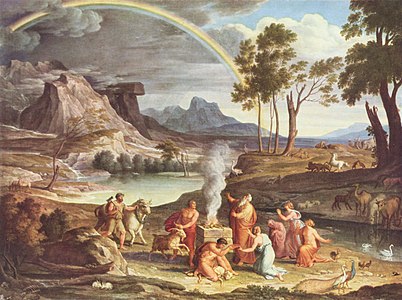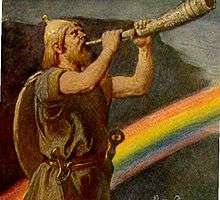Rainbows in mythology
The rainbow, a natural phenomenon noted for its beauty and mystical appearance, has been a favorite component of mythology throughout history. Rainbows are part of the myths of many cultures around the world. The Norse saw it as Bifrost; Abrahamic traditions see it as a covenant with God not to destroy the world by means of floodwater. Whether as a bridge to the heavens, messenger, archer's bow, or serpent, the rainbow has been pressed into symbolic service for millennia. There is a myriad of beliefs concerning the rainbow. The complex diversity of rainbow myths are far-reaching, as are their inherent similarities.

Bridges

In Norse religion, a burning rainbow bridge called the Bifrost connects Midgard (earth) with Asgard, home of the gods.[1] Bifrost can be used only by gods and those who are killed in battle. It is eventually shattered under the weight of war – the Ragnarok (German Götterdämmerung). The notion that the rainbow bridge to heaven is attainable by only the good or virtuous, such as warriors and royalty, is a theme repeated often in world myths.
In the ancient beliefs of Japan, rainbows were the bridges that human ancestors took to descend to the planet.[1]
In Navajo tradition, the rainbow is the path of the holy spirits, and is frequently depicted in sacred sandpaintings.[2]
Māori mythology tells a tale of Hina, the moon, who caused a rainbow to span the heavens even down to the earth, for her mortal husband to return to earth to end his days, since death may not enter her celestial home.[3]
Messenger
In Greek mythology, Iris is the personification of the rainbow and a messenger linking the gods to humanity. Iris is frequently mentioned as a divine messenger in the Iliad. She carries a caduceus or winged staff. Iris's messages often concerned war and retribution.[4] However, like many Greek gods, Iris is continually being redefined. The rainbow eventually became solely a mode of transportation for Iris, who proves to be as elusive and unpredictable as the rainbow itself.
Anuenue, the rainbow maiden, appears in Hawaiian legends as the messenger for her brothers, the gods Tane and Kanaloa.[5]
Archer's bow
The rainbow is depicted as an archer's bow in Hindu mythology. Indra, the god of thunder and war, uses the rainbow to shoot arrows of lightning.[1]
Sumerian mythology
A rather ambiguous perception of the rainbow strikes a vein in all world culture, through its entire storied past.
The Epic of Gilgamesh, who was an ancient Sumerian king (c. 3000 BC), is our first detailed written evidence of human civilization. In a Victorian translation of a Gilgamesh variant, Leonidas Le Cenci Hamilton's Epic of Ishtar and Izdubar, King Izdubar sees "a mass of colors like the rainbow’s hues" that are "linked to divine sanction for war." Later in the epic, Izdubar sees the "glistening colors of the rainbow rise" in the fountain of life next to Elam’s Tree of Immortality.
The Sumerian farmer god Ninurta defends Sumer with a bow and arrow, and wore a crown described as a rainbow.
Australian aboriginal mythology
In Australian Aboriginal mythology, the rainbow snake is the Creator (Kurreah, Andrenjinyi, Yingarna, Ngalyod and others) in the Dreaming, which is the infinite period of time that "began with the world's creation and that has no end. People, animals, and Eternal Beings like the Rainbow Serpent are all part of the Dreaming, and everyday life is affected by the Dreaming's immortals," in almost every Australian Aborigine tribe. In these tribes, of which there are over 50, actual rainbows are gigantic, often malevolent, serpents who inhabit the sky or ground. This snake has different names in different tribes, and has both different and similar traits from tribe to tribe.
The theme consistent with most Australian tribes is that the Rainbow Serpent is the creator of the world and all beings. During the dry season, the Rainbow Serpent retreats to deep waterholes. Another common theme among all aboriginal tribes is that the Rainbow Serpent has no gender. And while the Rainbow Serpent can give fertility by creating rain, it can also let loose blindness and disease. "The Aboriginal Rainbow is humanity, because it causes the 'energy' and the 'breath' that gives people life."
Ngalyod, first-born son of Yingarna, who is the Rainbow Serpent creator of the Kunwinjku in western Arnhem Land in Australia—sucks up water during the dry season and spits it out as rain during the wet season. Like Iris, Ngalyod helps to ensure fertility with rains, but he can destroy as well as nurture. Yingarna, the creator of the Kunwinjku people, is "nominally female" and androgynous like her son Ngalyod. She possesses cunningly ambivalent form; as she combines elements of snake, fish, crocodile, catfish, emu, and kangaroo. The Estonian Rainbow Serpent, like the Aborigines' Ngalyod, sucks up water and spits rain, and also has a confused identity – it possesses an ox's head on its serpent body.
Abrahamic mythology
According to Genesis, after Noah saved the animals from the Great Flood, a rainbow appeared. As the flood had killed all other living beings, the rainbow came to symbolise God's promise that he would never send another flood to destroy all of the earth and that never again would all living things be killed in the waters of a flood.[4]
Other mythologies
- For some native people the rainbow around the sun is considered to be a sign from God, marking a time of great change.
- The Legend of the Rainbow Warriors was said to be an ancient Native American prophecy, although it is known to have been invented during the 1960s by an Evangelical Christian religious tract [6]. Versions of the prophecy are as follows:
“The Whirling Rainbow – Prophecy There will come a day when people of all races, colors, and creeds will put aside their differences. They will come together in love, joining hands in unification, to heal the Earth and all Her children. They will move over the Earth like a great Whirling Rainbow, bringing peace, understanding and healing everywhere they go. Many creatures thought to be extinct or mythical will resurface at this time; the great trees that perished will return almost overnight. All living things will flourish, drawing sustenance from the breast of our Mother, the Earth.
The great spiritual Teachers who walked the Earth and taught the basics of the truths of the Whirling Rainbow Prophecy will return and walk amongst us once more, sharing their power and understanding with all. We will learn how to see and hear in a sacred manner. Men and women will be equals in the way Creator intended them to be; all children will be safe anywhere they want to go. Elders will be respected and valued for their contributions to life. Their wisdom will be sought out. The whole Human race will be called The People and there will be no more war, sickness or hunger forever” ~Ancient American Indian Prophecy
- In Armenian mythology rainbow – is a belt of Tir, which was originally a god Sun, and then – god of knowledge. Eating options are apricot's belt, the belt of Our Lady or the Arch of God.
- In a Chinese folktale, Hsienpo and Yingt’ai are star-crossed lovers who must wait until the rainbow appears to be alone together. Hsienpo is the red in the rainbow, and Yingt’ai is the blue.[4] Hong is another name for the rainbow with various associated legends and interpretation.
- The Sumu of Honduras and Nicaragua "may simply refer to the rainbow as walasa aniwe, ‘the devil is vexed’". These people hide their children in their huts to keep them from looking or pointing at the rainbow.
- The Fang of Gabon (Africa) are initiated into the religion by a "transcendent experience when they arrive at the rainbow's center, for there they can see both the entire circle of the rainbow and of the earth, signaling the success of their vision." The Fang also prohibit their children from looking at the rainbow.
- The Ewe of Benin (Africa) who practice Vodun have a temple dedicated to the big python Dagbe Dre and small python Dagbe Kpohoun, related to Oxumare of the Yoruban Ifá of Nigeria and the diasporas. By way of Haiti the Loa is Ayida-Weddo as also the vodun in Benin.

- For Buddhists, the rainbow is "the highest state achievable before attaining Nirvana, where individual desire and consciousness are extinguished." Accordingly there is mention of a rainbow body.[7]
- For Karens of Burma, the rainbow is considered as a painted and dangerous demon that eats children.
- Izanami and Izanagi, the male and female creators of the world in Japanese myth, "descended on the Floating Bridge of Heaven to create land from the ocean of chaos." In many texts this bridge is known as a rainbow.
- Shamans among Siberia's Buryats speak of ascending to the sky-spirit world by way of the rainbow.
- In mythology of ancient Slavs, a man touched by the rainbow is drawn to heaven, and becomes a "Planetnik" – half-demonic creature – which is under the power of the thunder and lightning god Perun.
- In Bulgarian legends, it is said that if you walk beneath a rainbow, you will change genders: if a man, you'll begin to think like a woman, and if a woman, you'll begin to think like a man. While most Bulgarians don't believe in the superstition, some of them tease each other and joke around. They might also say "The sun is shining, the rain is falling, a bear is getting married" (roughly translated-in the original verse, the last part rhymes).
- In Ireland, a common legend asserts that a "pot of gold" is to be found at the end of a rainbow, for the person lucky enough to find it. This treasure is, however, guarded by a Leprechaun.
- In Māori mythology there are several personifications for the rainbow, depending on its form, who usually appear representing omens and are appealed to during times of war. The most widespread of these are Uenuku and Kahukura.[3][5]
- In Mesoamerican cultures, Ix Chel is a maternal jaguar goddess associated with rain. Chel means rainbow in the Yucatán Poqomchi' language. Ix Chel wears a serpent headdress and presides principally over birth and healing.
- In Amazonian cultures, rainbows have long been associated with malign spirits that cause harm, such as miscarriages and (especially) skin problems. In the Amuesha language of central Peru, certain diseases are called ayona’achartan, meaning "the rainbow hurt my skin". A tradition of closing one's mouth at the sight of a rainbow in order to avoid disease appears to pre-date the Incan empire.
- In pre-Islamic Arabian mythology, the rainbow is the bow of a weather god, Quzaḥ, whose name survives in the Arabic word for rainbow, قوس قزح qaws Quzaḥ, 'the bow of Quzaḥ'.
- Rainbows are widely seen in Native American stories and prophecies. The Cherokee believe the rainbow forms the hem of the sun's coat.[8]
- In the myth of U Lakriah and Niaw wasa(Jaintias of Meghalaya, India) Rainbow is God's image which appeared before U Lakriah,
- Amitolane is a rainbow spirit from Zuni mythology (Native American tribe).
Modern depictions
- George MacDonald's 1867 The Golden Key uses the rainbow as a bridge.[4]
Notes
- "Rainbows in Mythology", National Geographic.
- Native American Rainbow Mythology
- Best, Elsdon. "Rainbow Myths", Maori Religion and Mythology, Part 2, p. 414, P.D. Hasselburg, Wellington, New Zealand, 1982.
- Lee Jr., Raymond L. and Fraser, Alistair B., The Rainbow Bridge: Rainbows in Art, Myth, and Science, Preface, p. viii, Penn State Press, 2001, ISBN 9780271019772
- Craig, Robert D., Handbook of Polynesian Mythology, p. 174, ABC-CLIO, 2004, ISBN 9781576078945
- Interview with Michael Niman
- Ray, Reginald (2001). Secret of the Vajra World: The Tantric Buddhism of Tibet. Shambhala Publications. p. 323. ISBN 9781570627729.
- Bastian, Dawn Elaine and Mitchell, Judy K., Handbook of Native American Mythology, ABC-CLIO, 2004, ISBN 9781851095339
References
- Chapter 1, The Rainbow Bridge: Rainbows in Art, Myth, and Science, Raymond L. Lee and Alistair B. Fraser, Penn State Press, 2001.
- The rainbow hurts my skin: Medicinal concepts and plants uses among the Yanesha (Amuesha), an Amazonian Peruvian ethnic group. Céline Valadeau, Joaquina Alban Castillo, Michel Sauvain, Augusto Francis Lorese and Geneviève Bourdy. Journal of Ethnopharmacology. Volume 127, Issue 1, 8 January 2010, Pages 175–192
- Utilizing Western and Traditional Remedies in the Peruvian Amazon. Webster, Patty